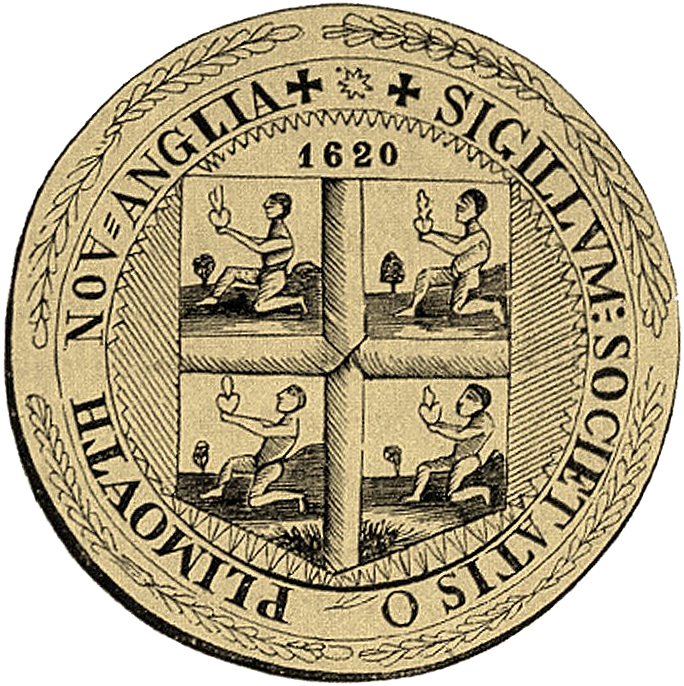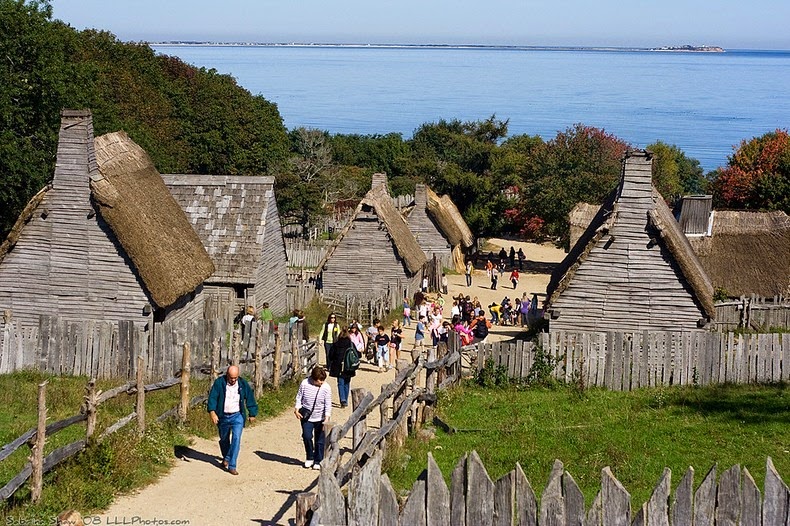The political situation in England in the early 17th century forced a group of religious separatists to flee the country. This group of people came to North America on a ship called Mayflower. They are known as the Pilgrim Fathers. In 1620 The pilgrims founded Plymouth Colony which today is the modern town of Plymouth, Massachusetts. It was the second successful English colony after Jamestown, Virginia.

In 1623, Emmanuel Altham – a visitor to Plymouth – wrote this about the town:
It is well situated upon a high hill close unto the seaside… In this plantation is about twenty houses, four or five of which are very fair and pleasant, and the rest (as time will serve) shall be made better. And this town is in such manner that it makes a great street between the houses, and at the upper end of the town there is a strong fort, both by nature and art, with six pieces of reasonable good artillery mounted thereon… This town is paled about with pale of eight foot long, or thereabouts, and in the pale are three great gates…. And lastly, the town is furnished with a company of honest men….
To make your experience even more interesting, there is a full-scale replica of the legendary Mayflower. The ship that brought the early colonist to Plymouth. Every detail of the ship is carefully re-created giving you a full picture of a 17th-century vessel. It is docked near the Plymouth Rock, the place where the original Mayflower supposedly brought the Pilgrims.
The people that you’ll meet here are costumed role players portraying the actual residents of Plymouth Colony. They have adopted the names, viewpoints and life histories of the people who used to live and work in the Colony.
They all have unique stories to tell. You can interact with them, ask them about their religious beliefs, education and child raising.
You can hear about their relations with Native People and discuss the difficulties they had in the early days of the colony.
Plimoth Plantation follows a timeline. The actors are reenacting events that happened in 1627 – from late March through November.
Depicting day-to-day life and seasonal activities as well as some key historical moments such as funerals and special celebrations.
Alongside the settlement is a re-creation of a Wampanoag home site, where you have the opportunity to hear modern Native People from a variety of nations explaining and demonstrating how their Wampanoag ancestors lived and interacted with the Pilgrim Fathers.
This museum brings colonial Plymouth vividly to life.
The Plimoth Plantation is a detailed re-creation of Plymouth Colony.
It is located only 2.5 miles south of the original 17th-century village.
You can see humble timber-framed houses furnished with reproductions of the objects that the original Pilgrims owned, storehouses, fields and fortification
The Pilgrims were not the first people in the area. Besides the indigenous tribes, there had been nearly a century of exploration, fishing, and settlement by Europeans.
Captain John Smith of Jamestown fame had explored the area in 1614 and is credited with naming the region of New England. He named many locations using approximations of Native American words. The future site of the Pilgrim’s first settlement was originally named “Accomack” by Smith
Using the financing secured from the Merchant Adventurers, the Colonists bought provisions and obtained passage on two ships, the Mayflower and the Speedwell
On December 21, 1620, the first landing party arrived at the site of what would later become the settlement of Plymouth. Plans to immediately begin building houses, however, were delayed by inclement weather until December 23. As the building progressed, twenty men always remained ashore for security purposes, while the rest of the work crews returned each night to the Mayflower. Women, children, and the infirm remained on board the Mayflower; many had not left the ship for six months
Despite its short history, fewer than 72 years, the events surrounding the founding and history of Plymouth Colony have had a lasting effect on the art, traditions, mythology, and politics of the United States of America.
![plimoth-plantation-16[2]](https://www.thevintagenews.com/wp-content/uploads/sites/65/2015/10/plimoth-plantation-162.jpg)
Source: wikipedia, amusingplanet, plimoth

![plimoth-plantation-1[2]](https://www.thevintagenews.com/wp-content/uploads/sites/65/2015/10/plimoth-plantation-12.jpg)
![plimoth-plantation-2[2]](https://www.thevintagenews.com/wp-content/uploads/sites/65/2015/10/plimoth-plantation-22.jpg)
![plimoth-plantation-3[2]](https://www.thevintagenews.com/wp-content/uploads/sites/65/2015/10/plimoth-plantation-32.jpg)
![plimoth-plantation-4[2]](https://www.thevintagenews.com/wp-content/uploads/sites/65/2015/10/plimoth-plantation-42.jpg)
![plimoth-plantation-5[2]](https://www.thevintagenews.com/wp-content/uploads/sites/65/2015/10/plimoth-plantation-52.jpg)
![plimoth-plantation-6[2]](https://www.thevintagenews.com/wp-content/uploads/sites/65/2015/10/plimoth-plantation-62.jpg)
![plimoth-plantation-7[2]](https://www.thevintagenews.com/wp-content/uploads/sites/65/2015/10/plimoth-plantation-72.jpg)
![plimoth-plantation-8[2]](https://www.thevintagenews.com/wp-content/uploads/sites/65/2015/10/plimoth-plantation-82.jpg)
![plimoth-plantation-9[2]](https://www.thevintagenews.com/wp-content/uploads/sites/65/2015/10/plimoth-plantation-92.jpg)
![plimoth-plantation-10[2]](https://www.thevintagenews.com/wp-content/uploads/sites/65/2015/10/plimoth-plantation-102.jpg)
![plimoth-plantation-11[2]](https://www.thevintagenews.com/wp-content/uploads/sites/65/2015/10/plimoth-plantation-112.jpg)
![plimoth-plantation-12[2]](https://www.thevintagenews.com/wp-content/uploads/sites/65/2015/10/plimoth-plantation-122.jpg)
![plimoth-plantation-13[2]](https://www.thevintagenews.com/wp-content/uploads/sites/65/2015/10/plimoth-plantation-132.jpg)
![plimoth-plantation-14[2]](https://www.thevintagenews.com/wp-content/uploads/sites/65/2015/10/plimoth-plantation-142.jpg)
![plimoth-plantation-15[2]](https://www.thevintagenews.com/wp-content/uploads/sites/65/2015/10/plimoth-plantation-152.jpg)